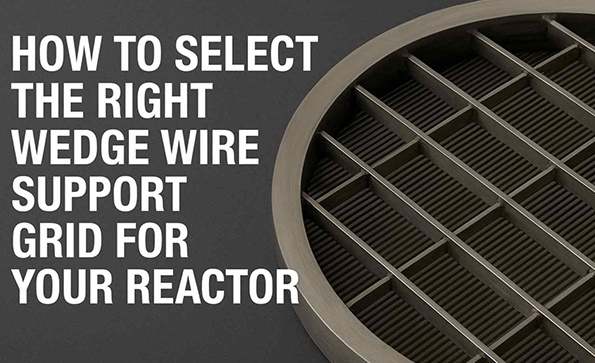Reactor internals play a decisive role in process efficiency, reliability, and long-term operational stability. Among these, the wedge wire support grid—often installed beneath the catalyst bed—ensures uniform flow distribution, prevents catalyst leakage, and withstands harsh operating conditions. Choosing the wrong grid can result in pressure drop, uneven flow, premature catalyst deactivation, and costly downtime.
This engineer's checklist will guide you step by step through the key considerations when selecting a wedge wire support grid for your reactor.
Slot size determines particle retention and liquid distribution.
Too wide → catalyst leakage; too narrow → unnecessary pressure drop.
Typical slot sizes range from 0.2 mm to 2 mm, depending on catalyst type.
Open area percentage should balance flow capacity with structural strength.
✔ Checklist: Confirm catalyst particle size, flow regime, and minimum slot size tolerance.
Reactor support grids must hold the full weight of the catalyst bed, plus withstand fluid pressure and potential thermal cycling.
Consider load-bearing beams and reinforcement ribs for large reactors.
Calculate allowable deflection under full catalyst load.
Ensure grid design matches maximum differential pressure conditions.
✔ Checklist: Verify load ratings, beam design, and welding quality.
Material choice has a direct impact on lifespan and performance.
304, 316L Stainless Steel: cost-effective, good corrosion resistance.
Duplex Stainless Steels: excellent strength, chloride resistance.
Special Alloys (e.g., Hastelloy, Inconel): for high-temperature, highly corrosive environments.
✔ Checklist: Match material to process fluids, temperature profile, and corrosion potential.

Reactors often operate under high thermal cycles. Wedge wire grids must accommodate:
Expansion/contraction of panels.
Proper sector design for large diameters.
Gaps or tolerances to prevent warping and buckling.
✔ Checklist: Ensure design includes thermal allowances and modular sections for assembly.
Practical aspects can make or break a design:
Segmented panels for manway access in large reactors.
Easy installation and alignment inside the vessel.
Options for quick replacement during maintenance.
✔ Checklist: Check panel size vs. access points, lifting arrangement, and fastening method.
No two reactors are identical. Customization ensures maximum reliability:
Non-standard geometries (conical heads, dished bottoms).
Special slot configurations for multiphase flows.
Enhanced structural supports for high-load beds.
✔ Checklist: Consider custom fabrication to match exact reactor specifications.
Finally, the most important factor: the expertise of your supplier. A manufacturer with custom design, precision fabrication, and strict QA, QC processes will ensure your grid performs reliably under the harshest conditions.
Choosing the right wedge wire support grid is not just about material or slot size—it requires a systematic approach that balances process requirements, mechanical integrity, corrosion resistance, and practicality during installation.
At YUBO, we specialize in custom reactor internals wedge wire components, engineered to meet your exact specifications. From small reactors to large petrochemical vessels, our grids are designed for performance, reliability, and long service life.
Contact us today with your reactor specifications and get a tailored design solution.
1. What is a wedge wire support grid in a reactor?
A wedge wire support grid is a precision-engineered internal structure that supports the catalyst bed inside a reactor. It ensures uniform flow distribution, prevents catalyst leakage, and withstands high mechanical and thermal loads.
2. How do I choose the right slot size for a reactor support grid?
The slot size depends on the catalyst particle size and process conditions. Typically, slots range from 0.2 mm to 2 mm. Smaller slots prevent catalyst leakage, while larger slots allow higher flow capacity with lower pressure drop.
3. What materials are commonly used for wedge wire reactor internals?
The most common materials are 304/316L stainless steel for general use, duplex stainless steels for higher strength and chloride resistance, and alloys like Hastelloy or Inconel for high-temperature or corrosive environments.
4. Can wedge wire support grids be customized for my reactor?
Yes. Wedge wire grids can be fully customized in terms of slot size, panel geometry, material grade, reinforcement design, and assembly method. Customization ensures the grid fits perfectly within your reactor and meets process-specific requirements.
5. What are the advantages of wedge wire support grids compared to perforated plates?
Wedge wire support grids offer:
Higher open area and better flow distribution.
Precise slot control for accurate catalyst retention.
Stronger resistance to clogging and fouling.
Longer service life under thermal and mechanical stress.
6. How can I request a quote for a custom wedge wire support grid?
Simply provide your reactor specifications—including diameter, catalyst type, operating conditions (pressure, temperature), and desired slot size. Our engineering team will prepare a custom design and quotation tailored to your process needs.